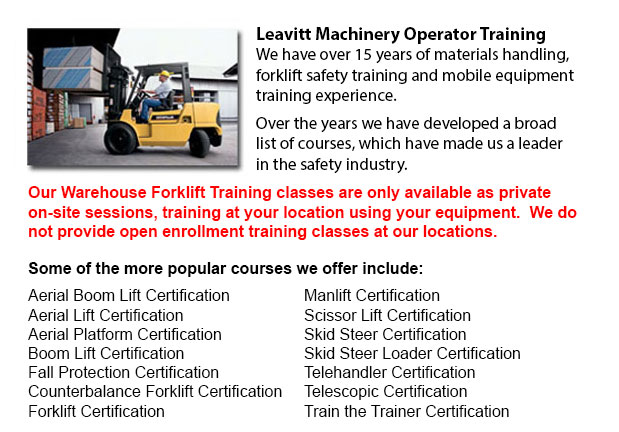
Warehouse Forklift Training Programs Burlington - Warehouses could be retail, industrial or commercial facilities. Their function can range from retailing bulk products to product distribution. Regardless of the kind of warehouse, personnel in warehouse settings should be trained well in safety measures related to material storage and handling, loading docks, conveyor systems, and forklifts and pallet jacks. Good housekeeping is important to a safe and orderly warehouse environment.
The loading dock system is normally build into the warehouse at a height from the ground making it easy to move things moving out and coming in of the warehouse. Workers will also load and unload merchandise and materials from the elevated docks and ramps. Particular attention must be paid to safety habits in this stage. To prevent falls, install yellow striping along the edge of ramps and docks. Pay attention to the area all-around delivery trucks which are parked at the loading dock, especially the area between dock and the truck. Be certain that when unloading, truck wheels are chocked.
Some warehouses utilize conveyor systems to distribute products inside the facility. Conveyor systems have moving belts and wheels which pose a pinch point hazard. Keep hair and parts of the body well away from conveyors to prevent injury. Elevated conveyors pose a hazard to employees underneath if safety nets are absent. Employees need to know how to stop conveyors in case of emergency. Be aware of the location of emergency stop buttons and off switches. When servicing conveyors, lock out/tag out procedures are mandatory.
Forklifts and pallet jacks are designed to move materials around the warehouse. Operators of forklifts are required to take training and receive certification. Operators of pallet jacks do not need certification, but should be trained on the machine. Training programs instruct operators in the right methods for hoisting objects and transporting them to their assigned location. Neither forklifts nor pallet jacks should ever be made use of to transport or lift employees.
Rack system and storage shelving help to create an orderly and efficient work space if they are sturdy, braced, and allow enough room for people and machines to pass. Slow and careful placement of good is needed to avoid accidents caused by products falling off the facing aisle. Aisles must be kept clear by storing products flat and inside the shelving units. Pallets are made use of for stacking products. They should be in good condition, and palleted products must be baled or shrink-wrapped, whenever possible.
PPE or likewise referred to as personal protective equipment must be worn when needed to help protect the employees' heads, limbs, hands and feet. Hard hats or bump caps, steel-toed shoes and gloves are common PPE.
Slippery floors which are pocked with dents and pits can present significant hazards, making good housekeeping extremely essential. Warehouse docks and floors must be clear of dirt, debris and oil. The area must be kept clear of trash, boxes and baling materials.
-
Order Picker Training Burlington
Order Picker Training Burlington - Order picker's enables warehouse employees to lift pallets using forks. Also called a stock picker, this particular electrically-powered equipment is similar to a forklift except that an order picker is likewise uti... More -
Crane Certification Burlington
Crane Certification Burlington - The Crane Certification training program includes content recommended by industry regarding the efficient and safe operation of cranes. Trainees would learn the following: how to identify cranes and their component pa... More -
Overhead Crane Training Burlington
Overhead Crane Training Burlington - The overhead crane is a piece of equipment which can lift and move huge, heavy objects which can't be handled by hands. Typically, overhead cranes are fixed in place. These equipment are capable of moving huge vol... More -
Aerial Lift / Boom Lift / Man Lift / Scissor Lift Training in Burlington
Lift tables or scissor lifts could elevate both people and goods vertically. They are normally used in construction, commercial and industrial environments. Commonly, the use of a scissor lift is to lift and lower supplies from one floor of a job loc... More -
Telehandler Operator Training Burlington
Telehandler Operator Training Burlington - Telescopic Handler forklifts or telehandler forklifts are usually found on construction places and their popularity continues to rise. The versatility of telehandler forklifts ensures that they are a valuabl... More -
Forklift Training Classes Burlington
Forklift Training Classes Burlington - Forklift are heavy pieces of industrial machines that are made use of in transporting and the handling of merchandise and materials. They are often known as Lift trucks and are found in all sorts of businesses.... More -
Boom Lift Training Burlington
Boom Lift Training Burlington - Aerial platforms or also known as elevated work platforms are devices that allow workers to perform tasks and duties at elevated heights that would not be otherwise accessible. There are a variety of aerial lifts avail... More -
Bucket Truck Training Burlington
Bucket Truck Training Burlington - The Vehicle-Mounted Aerial Work Platform or also called bucket truck training program is intended to decrease the risk of incident and personal injury while working in close proximity or with bucket trucks by effici... More

Forklift Training Burlington
TOLL FREE: 1-888-254-6157
Burlington, Ontario
forklifttrainingburlington.com
Email Us
About Us


